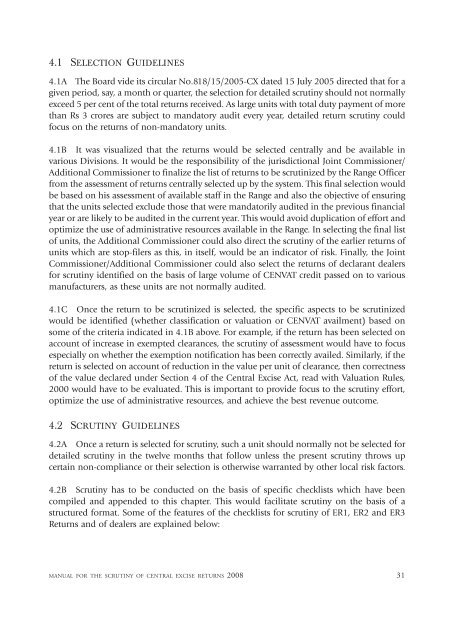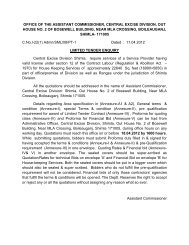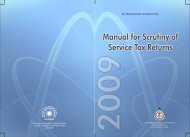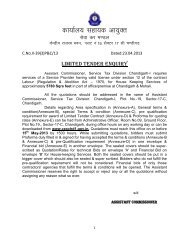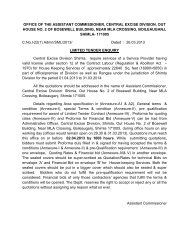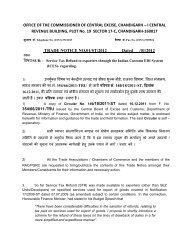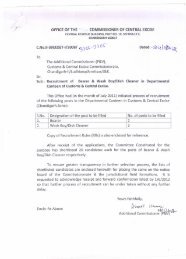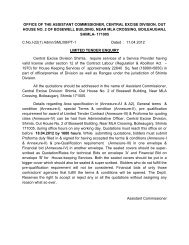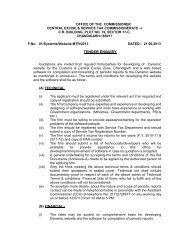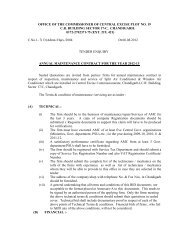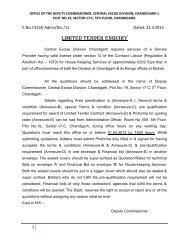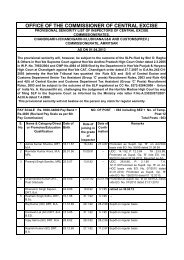Manual for the Scrutiny of Central Excise Returns 2008
Manual for the Scrutiny of Central Excise Returns 2008
Manual for the Scrutiny of Central Excise Returns 2008
- No tags were found...
You also want an ePaper? Increase the reach of your titles
YUMPU automatically turns print PDFs into web optimized ePapers that Google loves.
4.1 SELECTION GUIDELINES4.1A The Board vide its circular No.818/15/2005-CX dated 15 July 2005 directed that <strong>for</strong> agiven period, say, a month or quarter, <strong>the</strong> selection <strong>for</strong> detailed scrutiny should not normallyexceed 5 per cent <strong>of</strong> <strong>the</strong> total returns received. As large units with total duty payment <strong>of</strong> morethan Rs 3 crores are subject to mandatory audit every year, detailed return scrutiny couldfocus on <strong>the</strong> returns <strong>of</strong> non-mandatory units.4.1B It was visualized that <strong>the</strong> returns would be selected centrally and be available invarious Divisions. It would be <strong>the</strong> responsibility <strong>of</strong> <strong>the</strong> jurisdictional Joint Commissioner/Additional Commissioner to finalize <strong>the</strong> list <strong>of</strong> returns to be scrutinized by <strong>the</strong> Range Officerfrom <strong>the</strong> assessment <strong>of</strong> returns centrally selected up by <strong>the</strong> system. This final selection wouldbe based on his assessment <strong>of</strong> available staff in <strong>the</strong> Range and also <strong>the</strong> objective <strong>of</strong> ensuringthat <strong>the</strong> units selected exclude those that were mandatorily audited in <strong>the</strong> previous financialyear or are likely to be audited in <strong>the</strong> current year. This would avoid duplication <strong>of</strong> ef<strong>for</strong>t andoptimize <strong>the</strong> use <strong>of</strong> administrative resources available in <strong>the</strong> Range. In selecting <strong>the</strong> final list<strong>of</strong> units, <strong>the</strong> Additional Commissioner could also direct <strong>the</strong> scrutiny <strong>of</strong> <strong>the</strong> earlier returns <strong>of</strong>units which are stop-filers as this, in itself, would be an indicator <strong>of</strong> risk. Finally, <strong>the</strong> JointCommissioner/Additional Commissioner could also select <strong>the</strong> returns <strong>of</strong> declarant dealers<strong>for</strong> scrutiny identified on <strong>the</strong> basis <strong>of</strong> large volume <strong>of</strong> CENVAT credit passed on to variousmanufacturers, as <strong>the</strong>se units are not normally audited.4.1C Once <strong>the</strong> return to be scrutinized is selected, <strong>the</strong> specific aspects to be scrutinizedwould be identified (whe<strong>the</strong>r classification or valuation or CENVAT availment) based onsome <strong>of</strong> <strong>the</strong> criteria indicated in 4.1B above. For example, if <strong>the</strong> return has been selected onaccount <strong>of</strong> increase in exempted clearances, <strong>the</strong> scrutiny <strong>of</strong> assessment would have to focusespecially on whe<strong>the</strong>r <strong>the</strong> exemption notification has been correctly availed. Similarly, if <strong>the</strong>return is selected on account <strong>of</strong> reduction in <strong>the</strong> value per unit <strong>of</strong> clearance, <strong>the</strong>n correctness<strong>of</strong> <strong>the</strong> value declared under Section 4 <strong>of</strong> <strong>the</strong> <strong>Central</strong> <strong>Excise</strong> Act, read with Valuation Rules,2000 would have to be evaluated. This is important to provide focus to <strong>the</strong> scrutiny ef<strong>for</strong>t,optimize <strong>the</strong> use <strong>of</strong> administrative resources, and achieve <strong>the</strong> best revenue outcome.4.2 SCRUTINY GUIDELINES4.2A Once a return is selected <strong>for</strong> scrutiny, such a unit should normally not be selected <strong>for</strong>detailed scrutiny in <strong>the</strong> twelve months that follow unless <strong>the</strong> present scrutiny throws upcertain non-compliance or <strong>the</strong>ir selection is o<strong>the</strong>rwise warranted by o<strong>the</strong>r local risk factors.4.2B <strong>Scrutiny</strong> has to be conducted on <strong>the</strong> basis <strong>of</strong> specific checklists which have beencompiled and appended to this chapter. This would facilitate scrutiny on <strong>the</strong> basis <strong>of</strong> astructured <strong>for</strong>mat. Some <strong>of</strong> <strong>the</strong> features <strong>of</strong> <strong>the</strong> checklists <strong>for</strong> scrutiny <strong>of</strong> ER1, ER2 and ER3<strong>Returns</strong> and <strong>of</strong> dealers are explained below:MANUAL FOR THE SCRUTINY OF CENTRAL EXCISE RETURNS <strong>2008</strong> 31


